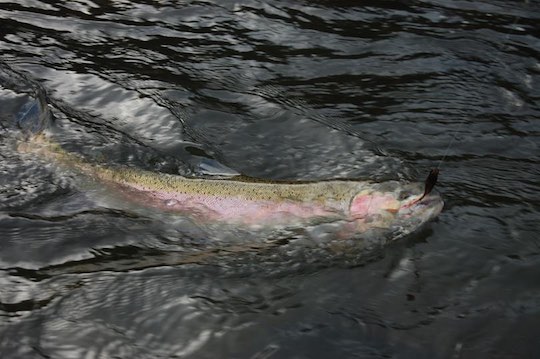forum
library
tutorial
contact

Snake River Early
Steelhead Run Looks Grim
by Rich Landers
Spokesman-Review, August 19, 2016
|
the film forum library tutorial contact |

|
Snake River Early
by Rich Landers
|
... the leading suspects are last year's poor ocean and poor out-migration conditions.
 FISHING -- Last year's warm water and low flows may be haunting steelheaders in the Snake River system this season.
FISHING -- Last year's warm water and low flows may be haunting steelheaders in the Snake River system this season.
Here's an update from Eric Barker of the Lewiston Tribune:
Fishing for the normally reliable run of steelhead that return to the Snake, Salmon and Grande Ronde rivers could be tough this fall.Counts of the A-run steelhead, which predominantly spend one year in the ocean, have been so low that regional fisheries managers dramatically scaled back their forecast. Before the season began, managers predicted about 230,000 A-run steelhead destined for tributaries of the Snake River and the upper and middle sections of the Columbia River would swim past Bonneville Dam. Now they expect only about 123,400 to make the trip. About half of those, or just less than 62,000, are expected to make it as far as Lower Granite Dam. The run is about 50 percent complete at Bonneville.
"What it looks like is pretty much a collapse of the one-salts," said Ron Roler of the Washington Department of Fish and Wildlife at Vancouver, referring to the portion of the A-run that spends one year in the ocean. "Usually the A-run are smaller steelhead and the majority (of them) are one-salt fish, with some two-salts. The two-salts look fine, it's the one-salts that are not showing up and this run is driven by one-salts, so it's looking really poor."
"There is no getting around it, it's bad," said Alan Byrne of the Idaho Department of Fish and Game at Boise.
Byrne used steelhead returning to the Pahsimeroi Fish Hatchery near Challis as an example. Normally, two-salt or two-ocean fish make up a little more than 20 percent of the run and the one-salt fish account for the rest. This year the numbers, measured at Bonneville, are flip-flopped, with two-salt fish accounting for 82 percent of the run and one-salt for 18 percent.
"There are very few one-ocean steelhead, it's true for the Snake River, the upper Columbia and the middle Columbia, and it's true for hatchery fish and it's true for wild fish," Byrne said. "The two-ocean component is not looking too bad, but it's not enough to make up for the extremely poor survival of the one-ocean component."
Both Byrne and Roler said it's too early to say how the B-run is shaping up. Those fish that mostly spend two years in the ocean and largely return to the Clearwater Basin are just starting to show up at Bonneville Dam.
Joe DuPont, regional fisheries manager for the Idaho Department of Fish and Game at Lewiston, said the poor showing has not prompted contemplation of bag limit changes on the Snake and Salmon rivers, where anglers can keep three hatchery steelhead per day. But he said lowering the bag limit is possible.
"If we think we can make a difference and we need to make a difference, we will," he said. "First of all, we need to make sure we get enough fish for brood, and then we need to make sure we distribute harvest to different areas and if we think a change will make a difference on those fronts, yeah we would do it."
The reason for the plunge of the one-salts isn't yet known, but the leading suspects are last year's poor ocean and poor out-migration conditions. The coastal regions of the northern Pacific Ocean were dominated by "the Blob" last summer, a mass of warm water that sapped the normally productive waters. The winter of 2014-15 also saw dismal snow accumulations and rivers throughout the Columbia Basin had below-normal runoff.
Roler noted that steelhead tend to go to areas beyond the footprint of the Blob, but he said it could have had an indirect effect by harming species lower on the food chain.
"It could be numerous different things that could effect them and maybe it was a conglomeration of all of that," he said. "Last year was not a good year for out-migration and not a good year out in the ocean."
learn more on topics covered in the film
see the video
read the script
learn the songs
discussion forum
